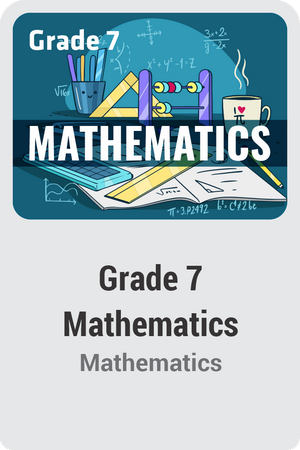
Course Overview:
Have you ever wondered, “When will I use this in real life?” Grade 7 Mathematics has great news! There are hundreds of ways that math is used in the real world, and this course is designed to help you think critically as you explore a few of those applications. With hands-on activities and interactive lessons, students will have the opportunity to apply what they learn in relevant ways. Key foundational concepts like proportional relationships, probability, and geometry will help prepare students for the next level of learning.
Instructional time for Grade 7 Mathematics will emphasize five areas:
- recognizing that fractions, decimals, and percentages are different representations of rational numbers and performing all four operations with rational numbers with procedural fluency
- creating equivalent expressions and solving equations and inequalities
- developing understanding of and applying proportional relationships in two variables
- extending analysis of two- and three-dimensional figures to include circles and cylinders
- representing and comparing categorical and numerical data and developing understanding of probability
- Access the link below to view the standards from the Florida Department of Education:
- Course standards
Prerequisites:
Grade 6 Mathematics
Required Materials:
You will need the following items to complete this course:
- Printer
Syllabus:
Segment One
- Solve problems by rewriting rational numbers in different but equivalent forms including fractions, mixed numbers, repeating decimals, and percentages
- Apply the Laws of Exponents to evaluate numerical expressions and generate equivalent numerical expressions, limited to whole number exponents and rational number bases, with procedural fluency
- Add, subtract, multiply, and divide rational numbers
- Solve real-world problems involving any of the four operations with rational numbers
- Solve mathematical problems using multi-step order of operations with rational numbers including grouping symbols, whole-number exponents, and absolute value
- Apply properties of operations to add and subtract linear expressions with rational coefficients
- Determine whether two linear expressions are equivalent
- Write and solve one-step inequalities in one variable within a mathematical context and represent solutions algebraically or graphically
- Write and solve two-step equations in one variable, where all terms are rational numbers
- Determine whether two quantities have a proportional relationship by examining a table, graph, or written description
- Translate any representation of a proportional relationship to a written description, table, or equation
- Determine the constant of proportionality given a table, graph, or written description of a proportional relationship
- Graph proportional relationships from a table, equation, or a written description
- Solve problems involving proportional relationships
- Solve problems involving the conversion of units across different measurement systems
- Solve multi-step, real-world percent problems
- Apply ratios to solve real-world problems involving proportions
Module 01: Numerical Expressions
- 01.00 Numerical Expressions Introduction
- 01.00 Numerical Expressions Pretest
- 01.01 Rewriting Rational Numbers
- 01.02 Adding and Subtracting Rational Numbers
- 01.03 Multiplying Rational Numbers
- 01.04 Dividing Rational Numbers
- 01.05 Order of Operations
- 01.06 Laws of Exponents with Whole Number Exponents
Module 02: Algebraic Equations and Inequalities
- 02.00 Algebraic Equations and Inequalities Introduction
- 02.00 Algebraic Equations and Inequalities Pretest
- 02.01 Adding and Subtracting Linear Expressions
- 02.02 Equivalent Linear Expressions
- 02.03 Solving Two-Step Equations
- 02.04 Writing Two-Step Equations
- 02.05 One-Step Inequalities
Module 03: Proportional Relationships
- 03.00 Proportional Relationships Introduction
- 03.00 Proportional Relationships Pretest
- 03.01 Proportional Relationships
- 03.02 Constant of Proportionality
- 03.03 Graphing Proportional Relationships
- 03.04 Real-World Proportional Problems
- 03.05 Proportions
- 03.06 Converting Between Systems
- 03.07 Multi-Step Percent Problems
- 03.08 Proportional Relationships Practice Exam
Segment Two
- Construct, display, and interpret data in circle graphs
- Choose and create an appropriate graphical representation given a real-world numerical or categorical data set
- Determine an appropriate measure of center or measure of variation to summarize numerical data, represented numerically or graphically, taking into consideration the context and any outliers
- Use the measure(s) of center and measure(s) of variability to make comparisons, interpret results, and draw conclusions about two populations given two numerical or graphical representations of data
- Use proportional relationships to make predictions about a population given categorical data from a random sample
- Solve problems involving dimensions and areas of geometric figures, including scale drawings and scale factors
- Apply a formula for the circumference of a circle to solve problems
- Apply a formula to find the area of a circle to solve problems
- Find the surface area of a right circular cylinder using the figure’s net
- Solve problems involving surface area of right circular cylinders
- Solve problems involving volume of right circular cylinders
- Apply formulas to find the areas of trapezoids, parallelograms, and rhombi
- Solve mathematical or real-world problems involving the area of polygons or composite figures by decomposing them into triangles or quadrilaterals
- Determine the sample space for a simple experiment
- Find the theoretical probability of an event related to a simple experiment
- Interpret the likelihood of a chance event occurring and compare the probabilities of chance events
- Find experimental probabilities and compare them to theoretical probabilities
Module 04: Probability
- 04.00 Probability Introduction
- 04.00 Probability Pretest
- 04.01 Sample Spaces
- 04.02 Theoretical Probability
- 04.03 Likelihood
- 04.04 Experimental Probability
Module 05: Geometry
- 05.00 Geometry Introduction
- 05.00 Geometry Pretest
- 05.01 Area of Polygons and Composite Figures
- 05.02 Scale Factor
- 05.03 Circumference
- 05.04 Area of Circles
- 05.05 Surface Area of Cylinders
- 05.06 Volume of Cylinders
Module 06: Statistics
- 06.00 Statistics Introduction
- 06.00 Statistics Pretest
- 06.01 Circle Graphs
- 06.02 Creating Graphical Representations
- 06.03 Appropriate Measures
- 06.04 Comparing Data
- 06.05 Making Predictions


